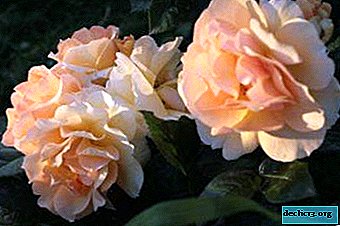What to do if an orchid has fusarium: a photo of the disease and treatment recommendations

Orchids among flower growers are considered the most capricious indoor flowers that require special care, since they grow in nature under specific conditions and not in the usual soil for us.
This exotic plant is the most beautiful with delicate and varied flowers.
In the case of orchid cultivation at home, you need to carefully study not only the care methods, but also the diseases to which the flowers are prone.
What is fusarium rot?
As a rule, orchids are affected by 3 types of diseases provoked by the following pathogens:
- Fungal lesions - the most numerous species, appear on the leaves in the form of plaques and dark brown putrefactive spots, quickly develop and lead to the destruction of flowers (about why orchids rot leaves and what to do about it, read here).
- Bacterial lesions - they often cause rhizomes to rot, gradually spreading to the entire plant, while the leaves of the plant change color from green to dark yellow, become stained and ulcerated.
- Viral diseasesin which leaves are covered with spots in the form of mosaic patterns of a round or dashed shape. This form of lesion is considered incurable.
The causes of orchid disease are different - lack of sunlight, excess or lack of humidity, overheating or hypothermia.
As noted above, the most common are fungal lesions of flowers. And among the fungal most common is Fusarium orchids.
Fusarium infection is a defeat of a plant by fungi of the genus Fusarium. It is considered an infectious and rather contagious disease. The fungus enters the flower through the rhizome or near-root zone of the stem, as well as through seeds or seedlings infected with fungal spores.
ATTENTION: In orchids, it occurs in the form of fusarium - the root, expressed in the decay of the roots of the plant, and the stem, affecting the stems, leaves and flowers, causing them to wither. Fungi propagate through multi-colored spores (conidia) - purple, white or pink.At the first manifestations on the stems and basal areas of pink and white dust particles in the form of tiny balls, it is necessary to separate the plant from other flowers and begin immediate treatment. Fungal diseases of pets are curable only in the early stages, before root damage.
Photo
Check out the photo of Fusarium in orchids:



Signs
Reproduction of Fusaria in the root system can last from 8 months to 1.5 years. Initially, the roots of the orchid, affected by fungal spores, redden, as if acquiring the color of a tan. Then impressions appear on the roots, as if they were tightly tied with thread. In the future, under the influence of an increasing number of spores, the red sections of the rhizomes darken and begin to rot (how to resuscitate an orchid if the roots are damaged or have already decayed can be found here).
Fungi secrete special toxins that leak in the nutrient vessels, poisoning the flower and gradually clogging the aisles. These toxins are clearly visible on sections of plants in the form of dark brown rings on the walls of blood vessels.
As a result, moisture ceases to flow into the cells of the plant, and they begin to die from a lack of fluid. The affected areas of the stem become dark brown in color, the stem becomes thinner (we told here about what to do if the core rots in the orchid; Leaves begin to turn yellow. The development of the disease begins with the top of the orchids and gradually spreads throughout the flower.
Causes
As known, any fungal begin to actively develop in a favorable environment:
- excess nitrogenous fertilizers;
- decrease in temperature in the soil;
- damage to the roots during transplantation or various insects;
- a large amount of water when watering;
- the prevalence of peat in the soil of the flower;
- the absence of microorganisms in the soil that strengthen the protective function of flowers;
- lack of air circulation in the room;
- salinity of the soil substrate.
What is the danger?
The lack of water in the plant cells due to clogging of the conducting vessels with toxins of fungi, as well as the destruction of the rhizome due to decay, leads to withering of the stems and leaves (about the causes of rot on the orchid and how to deal with it, read here). Also a diseased plant is a danger to the surrounding indoor flowerssince fungal spores are highly contagious.
Treatment
 In case of detection of fusarium on an orchid, the diseased flower must be isolated from other plants and proceed to treatment, which consists of the following steps:
In case of detection of fusarium on an orchid, the diseased flower must be isolated from other plants and proceed to treatment, which consists of the following steps:
- Pull the plant out of the pot and rinse it with warm water.
- Inspect it and cut off all the rotten fragments.
- Lubricate sections with activated carbon dissolved in water or an antiseptic.
- Dry the flower.
- To process the plant completely (roots, stems, leaves, flowers) with a fungicide (Benomil, Fundazol, Topsin, Fundazim). A solution of Fundazole is prepared at the rate of 1 g. powder per 1 liter water. Processing is carried out 3 times with an interval of 10 days.
- Plant a flower in a new pot.
- Place the flower pot in a well-lit, warm place.
- For prevention, before planting, you can also spray the soil substrate with a solution of Fundazole.
- Water only the roots, on the leaves and trunks of moisture should not be.
- For watering, it is also necessary to use a fungicidal solution, which, together with water falling into the flower, will treat it from the inside.
- The orchid must be in the picture for at least 3 weeks.
In case of fungus damage to the whole plant, especially the root system, the orchid must be destroyed along with the soil. Reuse of the pot is possible only after disinfection in a solution of copper sulfate (5%).
Fusarium fungi are very tenacious in nature. In most cases, up to 70% of spores die during treatment, and 30% can fall into a kind of hibernation and activate after a certain period of time. Fungi live for a long time in the soil and on parts of the dead plant.
Prevention
To prevent the development of Fusarium orchids, it is enough to follow the basic rules for caring for flowers:
 regulation of humidity of air and soil by airing the room and loosening the soil;
regulation of humidity of air and soil by airing the room and loosening the soil;- observe the temperature regime (not lower than 15 degrees);
- treat the substrate before planting with disinfectants;
- prevent frequent and abundant watering of plants;
- in the soil of peat and polystyrene should be no more than 20%;
- carry out a flower transplant every six months to avoid salinization of the soil;
- when fertilizing, comply with the norms of input substances
- provide sufficient lighting for orchids;
- regular inspection of the plant and the surface of the soil in the pot.
Further care
IMPORTANT: After the orchid has had a fungal infection, it is necessary within 3 months from the moment of detection of the disease to carry out preventive treatment of the plant and watering the roots with a solution of fungicides.It is recommended to process the flowers on the day of irrigation, when high humidity is maintained. The orchid is especially carefully treated during plant growth, paying great attention to new sprouts.
To stimulate the growth of new sprouts on an orchid, a paste with the hormone cytokinin is used. A pot of flowers should be placed in a warm, bright room. At the same time, direct sunlight should be avoided. The leaves of the plant darken with a deficit of light, if they turn yellow - this indicates an excess of lighting and heat.
Experienced flower growers recommend choosing light or transparent plastic pots for orchids to protect the roots from overheating. To ensure good ventilation of the roots, many holes are made at the bottom of the pot; the bottom of the pot is covered with drainage.
Orchids are watered depending on the season - in the summer every 3 days, in the winter - every 10 days. Orchids are very fond of moisture, so it is useful to periodically spray the plant with warm water. In order to avoid the re-development of fungi, spraying is best done in the morning so that the moisture on the leaves has time to evaporate.
Of great importance for a weakened plant is proper feeding with special fertilizers. In winter, top dressing is carried out once every 30 days, during the germination of new shoots, fertilizers are applied every 2 weeks.
Conclusion and Conclusions
Compliance with all the rules for caring for this exotic flower and preventive measures will avoid such a formidable orchid disease as fusarium. As a result of timely treatment and further special care, the plant will delight others with unusual, beautiful and delicate flowers for a long time.

 regulation of humidity of air and soil by airing the room and loosening the soil;
regulation of humidity of air and soil by airing the room and loosening the soil;















